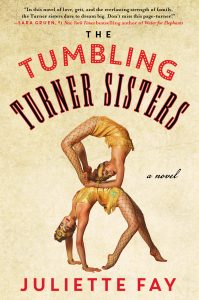Tumbling into Historical Fiction: An Interview with Juliette Fay
Janice Derr
 “It wasn’t a career that I was after. It was just that I wanted a life that didn’t mean spending most of it at the cookstove and the kitchen sink.” — Sophie Tucker, singer
“It wasn’t a career that I was after. It was just that I wanted a life that didn’t mean spending most of it at the cookstove and the kitchen sink.” — Sophie Tucker, singer
One imagines a similar quote might come from the characters in Juliette Fay’s The Tumbling Turner Sisters (Gallery, 2016). The Turner sisters don’t have much, but they are getting by until their father injures his hand in a bar fight and is unable to continue work in a shoe factory. Desperate to pay the rent, their mother proposes that the girls put together an acrobatic act they can take on the road. Traveling from theater to theater, the sisters find themselves in the middle of a whole new world.
This is Fay’s fourth novel, but her first foray into historical fiction. “I’ve always loved reading historical fiction, but questioned whether I had the background to write it. Don’t you need some sort of history degree to write about a completely different time? As it turns out, the answer is no. As with any story about a complicated topic — for instance, if a character has a certain medical condition or line of work that’s central to the story — you just have to be willing to submerge yourself in the subject matter and learn everything you can.”
Fay has a personal connection to her novel’s vaudeville setting, since her great-grandfather was a vaudeville performer. “To show my gratitude for his inspiration, I did name one of the characters after great-grandpa Fred. However, since I knew so little of his performing life, I had to make most of it up. This actually gave me a lot of freedom to make the character work well for the story, instead of being constrained to Fred’s real-life experiences.”
The time period also drew Fay in: “The world was changing quickly in 1919, just after World War I, with Prohibition and women’s suffrage on the horizon. These social and political changes forced people take a look at the way things had always been done, and start to question if there weren’t better ways.”
Fay explores these social changes through her character, Winnie. The second youngest Turner sister has aspirations beyond the stage and dreams of attending college and studying medicine. She is also an advocate of women’s rights and longs for the Nineteenth Amendment to pass. “Many people truly believed that the more freedom women had — to vote or work outside the home or not get married at all — the more society would degenerate until no one was taking care of hearth and home, and children would be running wild and unfed in the streets. (I am not making this up.) I didn’t feel I could tell a story about that time without talking about the changing role of women. Vaudeville, with its more open culture and fewer rules, was a great way for the Turner girls to get a sense of the broader possibilities.”
The novel also explores the racial inequalities both in and outside of vaudeville. The sisters befriend an African-American tap dancer named Tip who experiences both subtle and blatant racism. Fay says that many times African Americans were reduced to working poorer theaters in the south, referred to as the “Chitlin’ Circuit.” “Tip was talented enough to make it in the bigger circuits in the north, and because circuit and theatre owners mostly cared about the bottom line, if you could bring the crowds, they would hire you. But they wouldn’t necessarily treat you too well. Racism was so deeply embedded in the culture of the time that black performers were considered lucky to be there at all.”
Fay’s thorough research of the era brings the vaudeville stage to life and creates a rich and engrossing story. “The subculture of vaudeville was this crazy little brother-and-sisterhood, with its own customs, rules and slang. I learned far more than I could ever have put in the book, and it was a blast.”
About the contributor: Janice Derr is a librarian, an avid reader of historical fiction, and frequent reviewer for HNR.
______________________________________________
Published in Historical Novels Review | Issue 77, August 2016






